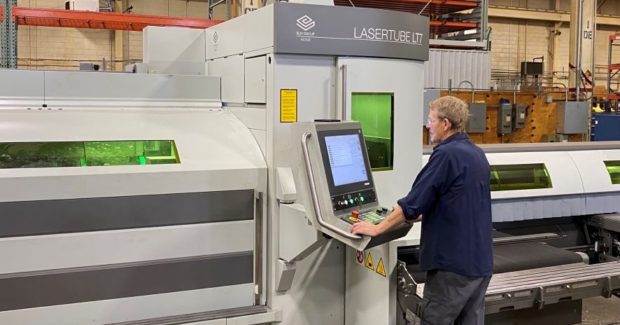Eventful Year Creates a Multitude of Opportunities Heading into 2022
Despite obstacles, U.S. fabrication shops continue to invest in new machinery to meet demand and increase efficiencies to expand product lines and attract new industries. In addition, according to ISM, the fabricated metal products sector continues to register moderate to strong growth.
Posted: November 24, 2021
EDITOR’S FORUM
by Rachel Duran
Increased demand at Sharpe Products in New Berlin, Wis., spurred a major capital investment to complement the company’s existing machine technology. “It is our company philosophy to invest in machine technology to accommodate a broad range of job specifications and to offer short lead times,” stated Paul Krickeberg, president and CEO of Sharpe Products.
The company, which provides custom pipe and tube bending, laser cutting and related fabrication services for commercial and industrial companies, is an example of an expanding company thriving in a strong manufacturing climate, albeit one with continued hurdles. The September Manufacturing PMI published by the Institute of Supply Management (ISM) registered at 61.1 percent, up from August’s reading of 59.9 percent. It was the 16th consecutive month of growth, as determined by the ISM. Nationwide, the expansion of the economy and job shops continues to be hampered by long lead times for materials, rising prices and supply chain struggles. In September, the Precision Metalforming Association (PMA) reported 61 percent of the respondents to its Business Conditions Report noted an increase in lead times, slightly down from 64 percent in August.
One of the approaches experts recommend companies consider during times of uncertainty is to invest in and embrace innovative technologies to better position their shops for success. New machinery and equipment purchases allow you to offer new services and products to customers, as well as market to new industries.
Sharpe Products installed a BLM GROUP LT7 4 kW laser cutting system. This equipment cuts round, square, rectangle and open profile pipe or tube up to 6-inch O.D. The operating software easily supports multiple operations. The laser system can be easily integrated with the company’s existing BLM GROUP tube bending machines and is expected to increase manufacturing efficiency for products that require features cut prior to the bending operation.
For KAPCO Metal Stamping in Grafton, Wis., the installation of four new presses supports the company’s growth, both from existing and new customers added during the pandemic. The company manufacturers metal components for companies that need stamping, fabrication and welding work. For KAPCO, much like manufacturers throughout the country, the instability of the global supply chain puts them and their products at risk. By investing in innovative technology, KAPCO is positioned for both organic and new business growth. The company also hired 100 new employees.
WHERE THINGS STAND
As we head into 2022, despite the economic challenges, the manufacturing sector appears to be on a steady, healthy track, based on surveys conducted by leading manufacturing organizations. According to NAM’s Manufacturers’ Outlook Survey for the third quarter of 2021 (surveys taken between August 19th and 30th), 87.5 percent of respondents felt either somewhat or very positive about their company’s outlook, down from 90.1 percent in the second quarter.
The outlook found small manufacturers (those with fewer than 50 employees) had the strongest outlook since the second quarter of 2019, with 83.1 percent positive, up from 80.2 percent in June. In contrast, medium (50 to 499 employees) and large (500 or more employees) manufacturers experienced some easing in confidence. For instance, 96.5 percent of large manufacturers felt positive in their outlook in the second quarter, which was a record, with 88.1 percent saying the same thing now.
In September, AMT – The Association for Manufacturing Technology reported July’s new manufacturing technology orders totaled $472.6 million, bolstered by industries making capital investments. The orders included an increase in motor vehicle stamping, food processing equipment, and agricultural equipment manufacturers. The July order total was a slight decrease of 5.6 percent from June’s orders.
“The amplified pace of orders over the past several months has injected a degree of confidence into manufacturing not seen since before the pandemic,” said Patrick McGibbon, chief knowledge officer at AMT. “Increased onshore capacity and diversified supply chains have made lead times more predictable and inventories more consistent, allowing manufacturers closer to end-use customers to justify the capital expenditures we are seeing in this month’s USMTO orders. While this is the general trend in manufacturing, there still are industries where supply chain issues remain an impediment, particularly industries whose products rely heavily on computer chips.”
How is your job shop positioned as we head into 2022?





